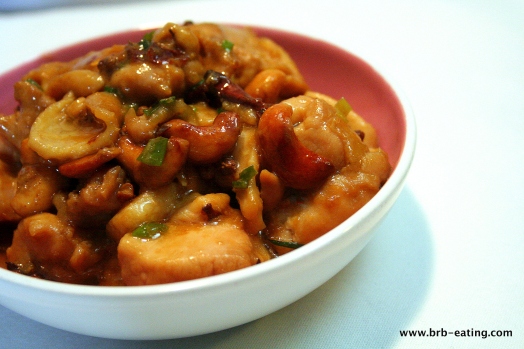This is part 2 of my two-part series on Kung Pao Chicken. Last week, I did a radio segment with a friend of mine at WBAI and Asian Pacific Forum. We talked about the history of Chinese Fast Food, specifically Kung Pao Chicken, its origin, and its evolution as it came to the US. I also cooked last week’s Kung Pao Chicken recipe (the Americanized version) and this one (the more authentic). Here is the recipe for that dish. I hope you enjoy it. And if you missed the radio segment, you can listen to it here.

Tongue numbing fun! Kung Pao Chicken, the right way.
I’m not good at moderation when it comes to seasoning. Growing up, the dishes that existed in my life were simple: a small amount of spices and a focus on just the ingredients. The major flavoring component was garlic, scallion, and or ginger. We’d add soy sauce or rice wine, but that was it. Without the addition of spice, everything was minimal, but still delicious. But, don’t get me wrong, I love spice – I love the earthy flavors that come out with the addition of a well toasted spice, the bright flavors that come out of herbs, and the layers of flavors that come with the combination of powders and grinds.
When I began to first play around with different herbs and spices, my brother – my official taste tester – was the unlucky one who had to deal with my heavy hand. Cooking with spices was such a new concept to me; When testing out a new spice, I always wanted to add enough of that particular spice in order to really understand its flavor profile. The three main culprits that I usually over seasoned with were: cinnamon, cumin, and peppercorns.
A few years ago, I made a black bean dish that had cinnamon in it as one of the components to the spice blend. When I was researching Mexican cooking styles, I learned that cinnamon was a common spice used in savory dishes. So when I was experimenting with the recipe, I asked my brother to be a test subject. He gladly accepted the offer. After my brother’s first bite, a look of uncertainty crossed his face:
“Why do these beans taste like cinnamon?”
“Good, you can taste the secret ingredient!”
“It’s all I taste, why did you put so much of it?”
“I wanted to make sure you tasted it, why? It’s not subtle?”
“Um…no”
Ok, fine. I’m not good at moderating my use of new spices. A similar interaction happened with cumin, too. However, this time, I used way too much of it while cooking, to the point where the whole house smelled like it. Normally, I would enjoy having the aroma from various spices fill the air, but this was a little too pungent. My brother likened it to a room full of Oregon hippies jazzercising with Richard Simmons. And, I do have to admit, the house did have a special funk that only the strongest deodorant could have fixed.
Unfortunately, because of me, my brother now hates cinnamon in savory dishes and anything with cumin in it
I think I realized my problem with over spicing when Szechuan Peppercorns were finally allowed into the States. From the 1960’s to 2005, the FDA banned the import of Szechuan Peppercorns; so, when I finally got my hands on some, I was destined to pull out every flavor that I could from it. I tried to make a braised beef noodle soup dish and wanted it to have the same spiciness that I had while in Taiwan. So, why not add some of that beautifully mind (and tongue) numbing peppercorns. Now, for folks who don’t know much about this spice: the pepper has this bright citrus and earthy flavor. But, the best part is the numbing effect that happens when you eat the peppercorn. It’s a slight zing to the tongue that makes everything fun to eat. Based on the amount that you use, the zing can last anywhere from a few seconds to half a minute. Key phrasing there is “based on the amount that you use.” I, however, was super excited to have access to these beautiful things and began to throw them in by the handful. My thought process? If they aren’t spicy then I might as well put a bunch in. Oops. My brother was upset that he couldn’t taste his dish, and I couldn’t respond, because I was drooling from all the numbing.
~stuff
3 c diced chicken, I used thigh meat
4 cloves garlic, sliced or grated
4 tbs soy sauce
4 tbs rice wine
2 tbs rice flour
2 tbs oil, canola or vegetable
1//4 c raw cashews
6 dried Chinese chili peppers
2 tbs Szechuan peppercorn
1//4 c scallion, minced
~steps
toss chicken with garlic, 3 tbs soy sauce, 3 tbs of the rice wine, and the rice flour and let sit for ten minutes
heat oil in a hot wok on high heat
toast cashews, chili pepper, and peppercorns in oil until fragrant, less than a minute
add chicken with marinade and stir constantly until almost cooked through, 2 minutes
pour the rest of the soy sauce and rice wine in the wok with the scallions and toss until fully cooked through, about 4 more minutes
-serves 4-












